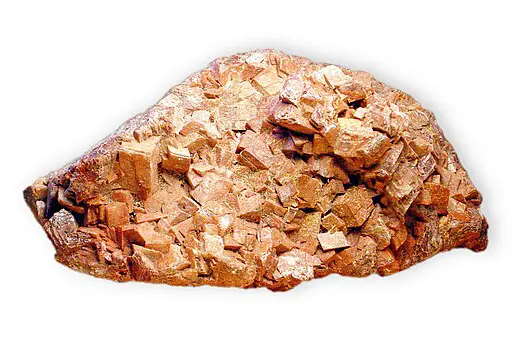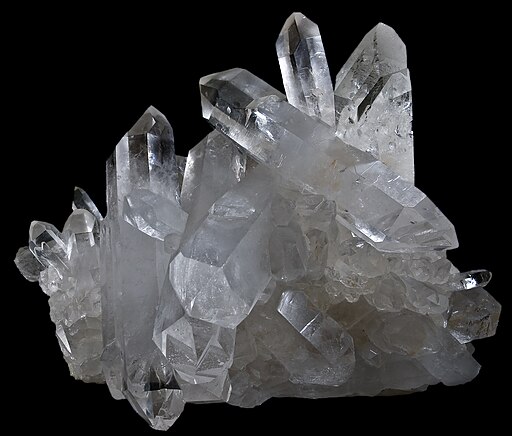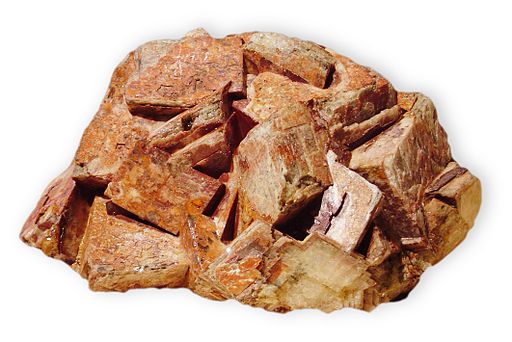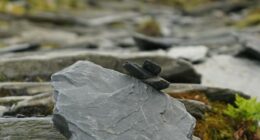Feldspar is a group of minerals with various colors, while quartz is a single mineral with clear to translucent appearance.
What is Feldspar?

Feldspar is a group of minerals that are abundant in the Earth’s crust and have a wide range of compositions and structures. It is composed of aluminum, potassium, sodium, and calcium silicates, and forms under high-temperature conditions. Feldspar is an essential component in many rocks, including granite, and is widely used in the ceramics industry for its ability to enhance the strength and durability of ceramic materials.
Composition and Structure of Feldspar
The composition and structure of feldspar can be understood through a table that highlights its chemical composition and crystal structure.
| Chemical Composition | Feldspar is a group of rock-forming minerals that consist of aluminum silicates combined with varying amounts of potassium, sodium, and calcium. The most common chemical formula of feldspar is KAlSi3O8 which represents potassium feldspar. Other compositions such as NaAlSi3O8 (sodium feldspar) and CaAl2Si2O8 (calcium feldspar) also exist. |
| Crystal Structure | Feldspar has a framework structure with a three-dimensional arrangement of silicon (Si) and aluminum (Al) tetrahedra. The tetrahedra are connected by sharing oxygen (O) atoms, forming a complex framework of linked tetrahedra. The arrangement of silicon, aluminum, and oxygen atoms contributes to the stability and physical properties of feldspar. |
Understanding the composition and structure of feldspar is crucial in various fields such as geology, ceramics, and mineralogy. It allows scientists and researchers to determine the mineral’s properties, its behavior under different conditions, and its applications in industries. By examining the chemical composition and crystal structure of feldspar, it becomes apparent why it is widely used in ceramics, glass manufacturing, and as a fluxing agent in metallurgical processes.
To delve further into the fascinating world of feldspar and quartz, continue reading the article. Exploring the differences between these minerals and their unique applications will provide a comprehensive understanding of their significance in various industries.
Common Types of Feldspar
Feldspar is a group of minerals that are widely found in the Earth’s crust. There are several common types of feldspar, each with its own unique characteristics.
Table: Common Types of Feldspar
| Type of Feldspar | Chemical Composition | Color |
|---|---|---|
| Orthoclase | KAlSi3O8 | Pink, white |
| Albite | NaAlSi3O8 | White, gray |
| Anorthite | CaAl2Si2O8 | White, gray |
| Microcline | KAlSi3O8 | Green, pink |
| L Labradorite | (Ca, Na)(Al, Si)4O8 | Gray, blue |
| Amazonite | (K, Na)AlSi3O8 | Blue-green |
Each type of feldspar has a specific chemical composition and color. Orthoclase is commonly pink or white, while albite and anorthite are often white or gray. Microcline can be green or pink, and labradorite is known for its gray or blue color. Amazonite, on the other hand, has a distinct blue-green hue.
Fact: Feldspar is an essential component of many rocks, including granite and gneiss. It is also widely used in the production of ceramics, glass, and paints due to its ability to lower the melting point of materials and increase their durability.
What is Quartz?

Quartz is a mineral that is composed of silicon and oxygen atoms, making it a silicate material. It is one of the most abundant minerals on Earth and can be found in various forms, including crystals, sand, and rock formations. Quartz is known for its high hardness and resistance to heat and chemical weathering, making it a valuable material in many industries.
Composition and Structure of Quartz
The composition and structure of quartz can be described as follows:
| Composition | Quartz is a mineral composed of silicon and oxygen atoms, with a chemical formula SiO2. |
| Crystal Structure | Quartz belongs to the hexagonal crystal system and has a trigonal structure. It forms six-sided prisms with a pyramid at one end. |
Quartz has a unique composition and structure that sets it apart from other minerals. The composition of quartz mainly consists of silicon and oxygen, which combines to form a rigid lattice structure. This distinct composition gives quartz its unique physical and optical properties.
Regarding the structure, quartz crystals are characterized by repeating units of silicon and oxygen tetrahedra. These interconnected tetrahedra create a three-dimensional framework, providing quartz with its inherent strength and resistance to chemical weathering.
In terms of properties, quartz possesses a hardness of 7 on the Mohs scale, thanks to its silicon and oxygen composition. It is classified as a transparent or translucent mineral with a vitreous or glass-like luster. Quartz crystals can display various colors, including clear, white, pink, purple, and smoky.
Quartz is widely found in different environments, ranging from igneous rocks, metamorphic rocks, to sedimentary deposits. It stands as one of the most abundant minerals on Earth, and its versatile applications include glass production, ceramics, electronics, and jewelry making.
Different Varieties of Quartz
| 1. Rose Quartz | Named for its pink color, rose quartz is a variety of quartz that ranges from pale pink to deep rose. It is commonly used in jewelry and is known as the stone of love and compassion. |
| 2. Amethyst | Amethyst is a purple variety of quartz. Its color can range from pale lilac to deep purple. It is a popular gemstone and is believed to have calming and protective properties. |
| 3. Citrine | Citrine is a yellow to orange-brown variety of quartz. Its color is often associated with warmth and positivity. It is commonly used in jewelry and is believed to bring success and abundance. |
| 4. Smoky Quartz | Smoky quartz is a brown to black variety of quartz. Its color is caused by natural radiation or the presence of aluminum in its crystal structure. It is valued for its grounding and protective properties. |
| 5. Clear Quartz | Clear quartz is colorless and transparent, also known as rock crystal. It is the most common variety of quartz and is often used in metaphysical and healing practices. It is believed to amplify energy and enhance spiritual growth. |
When exploring the Different Varieties of Quartz, you will come across rose quartz, amethyst, citrine, smoky quartz, and clear quartz. These varieties offer a range of colors and properties, making them suitable for various purposes. Rose quartz, with its pink hue, symbolizes love and compassion, while amethyst, in its purple brilliance, is said to have calming effects.
Citrine, with its warm yellow and orange tones, is often associated with success and abundance. Smoky quartz, in shades of brown and black, is valued for grounding and protection. Clear quartz, colorless and transparent, is believed to amplify energy and aid in spiritual growth.
Each variety has its own unique characteristics that make it a popular choice for jewelry, healing practices, and spiritual rituals.
Differences Between Feldspar and Quartz
Discover the fascinating disparities between feldspar and quartz. From their chemical composition to crystal structure, physical properties, and color and appearance, we’ll explore the unique traits that set these minerals apart. Unearth the distinct characteristics and remarkable qualities of feldspar and quartz in this comparison.
Chemical Composition
The chemical composition of feldspar and quartz can be compared and contrasted in the table below:
| Property | Feldspar | Quartz |
|---|---|---|
| Chemical formula | Al2O3 · K2O · Na2O · 6SiO2 | SiO2 |
| Composition ratio | Alumina, potassium oxide, sodium oxide, silica | Silica |
| Predominant elements | Aluminum, potassium, sodium, silica | Silicon, oxygen |
| Silica content | Varies depending on the type of feldspar | Pure silica |
| Other elements | May contain calcium, iron, and other trace elements | No additional elements |
| Variation in colors | Various colors such as pink, yellow, and white | Mostly colorless, but can occur in different colors |
Pro-tip: Understanding the chemical composition of feldspar and quartz is important for identifying their distinct properties and characteristics. While feldspar is a complex mixture of various elements, quartz is primarily composed of silica. This difference in chemical composition leads to variations in colors and properties between the two minerals. By examining the chemical composition, you can make informed decisions about the specific uses and applications of feldspar and quartz in different industries.
Crystal Structure
The crystal structure of feldspar and quartz can be understood through a comparison of their composition, arrangement of atoms, and overall symmetry.
| Feldspar | Quartz | |
|---|---|---|
| Composition | Composed of aluminum, silicon, and oxygen atoms | Composed of silicon and oxygen atoms |
| Structure | Made up of a framework of interconnected tetrahedrons | Made up of a network of interconnected tetrahedrons |
| Symmetry | Can exhibit multiple planes of symmetry | Exhibits a 3-fold rotational symmetry |
Feldspar and quartz differ in their crystal structure. The crystal structure of feldspar can be understood by examining its composition, arrangement of atoms, and overall symmetry. It is composed of aluminum, silicon, and oxygen atoms arranged in a framework of interconnected tetrahedrons. It can exhibit multiple planes of symmetry, which contribute to its unique crystal structure.
On the other hand, the crystal structure of quartz can be understood by examining its composition, arrangement of atoms, and overall symmetry. It is composed of silicon and oxygen atoms, forming a network of interconnected tetrahedrons. Quartz exhibits a 3-fold rotational symmetry, meaning it has a rotational symmetry of 120 degrees.
Understanding the crystal structure of feldspar and quartz is essential in various fields, including geology, materials science, and crystallography. It helps researchers identify and classify different minerals based on their structural characteristics.
Pro-tip: When studying minerals, examining their crystal structure can provide valuable insights into their properties and behavior.
Physical Properties
| Physical Property | Feldspar | Quartz |
| Hardness | 6 – 6.5 on the Mohs scale | 7 on the Mohs scale |
| Color | Variety of colors including white, pink, brown, and gray | Colorless to various shades of white, yellow, pink, and brown |
| Luster | Vitreous to pearly | Vitreous |
| Transparency | Transparent to translucent | Transparent to translucent |
| Cleavage | Perfect in two directions | No cleavage |
| Specific Gravity | 2.55 – 2.75 | 2.65 |
| Streak | White | White |
Feldspar and quartz can be compared and contrasted based on their physical properties. Feldspar has a lower hardness (6-6.5) compared to quartz (7) on the Mohs scale.
Additionally, feldspar comes in a variety of colors including white, pink, brown, and gray, while quartz is predominantly colorless but can also come in different shades of white, yellow, pink, and brown.
The luster of feldspar ranges from vitreous to pearly, while quartz has a vitreous luster. Both minerals are transparent to translucent and have a white streak.
Furthermore, feldspar exhibits perfect cleavage in two directions, whereas quartz does not have any cleavage. When comparing specific gravity, feldspar has a range of 2.55-2.75, slightly lower than quartz’s 2.65.
In the selection process between feldspar and quartz, it is important to consider their physical properties. The hardness, color, luster, transparency, cleavage, specific gravity, and streak of these minerals all play a significant role in determining their suitability for various applications.
Color and Appearance
The color and appearance of feldspar and quartz can vary significantly. Here is a table detailing the differences:
| Property | Feldspar | Quartz |
| Color | Varieties of feldspar can come in a range of colors including white, pink, orange, yellow, and green. | Quartz can be transparent, translucent, or opaque. It is commonly colorless, but can also be found in shades of white, pink, brown, black, and even purple. |
| Appearance | Feldspar has a vitreous to pearly luster and may show striations or twinning in its crystal form. | Quartz has a glassy to vitreous luster and typically forms hexagonal crystals. It often displays a conchoidal fracture, meaning it breaks into curved surfaces. |
The color of feldspar can be attributed to different impurities or crystal structure variations. Quartz, on the other hand, gets its color from trace elements present during its formation. The overall appearance of feldspar and quartz can be quite distinct, with feldspar often exhibiting more striations and twinning, while quartz tends to have a more glassy and hexagonal crystal form.
These variations in color and appearance make feldspar and quartz highly sought after for use in various applications such as building materials, ceramics, countertops, and jewelry. Their unique aesthetic qualities contribute to their versatile properties and wide range of uses.
Uses of Feldspar and Quartz
Feldspar and quartz: two minerals, countless uses. In this section, we explore the diverse applications of both feldspar and quartz. From construction to ceramics, we uncover the practicality and versatility of feldspar. Meanwhile, quartz shines as a key component in electronics and jewelry. So, whether it’s enhancing your home or powering your devices, join us as we uncover the valuable uses of feldspar and quartz.
Applications of Feldspar
| Applications of Feldspar | |
| Industry | Application |
| Glass | Feldspar is a crucial ingredient in glass production, providing strength, durability, and resistance to thermal shock. It is used in both container glass and flat glass manufacturing. |
| Ceramics | Feldspar is a key component in the production of ceramic materials. It acts as a flux, lowering the melting temperature of clay-based compositions and improving their workability. Feldspar is essential in the manufacturing of tiles, sanitaryware, tableware, and decorative objects. |
| Abrasives | Feldspar’s hardness and abrasive properties make it valuable in the production of abrasives. It is used in grinding wheels, sandpapers, and abrasive powders for various applications, including metal fabrication and polishing. |
| Pottery | Feldspar is an integral part of pottery production, enhancing the plasticity and firing characteristics of clay. It is used in both earthenware and stoneware pottery, providing strength and stability to the final products. |
| Fillers and Extenders | Feldspar is used as a filler and extender in various industries. It is added to paints, coatings, adhesives, and sealants to improve their performance and reduce costs. Feldspar fillers also enhance the properties of plastics, rubber, and resins. |
| Cement | In the construction industry, feldspar is used in the production of cement. It acts as a fluxing agent, aiding in the fusion of ingredients during the kiln process, leading to the formation of strong and durable cement. |
These are just a few examples of the wide-ranging applications of feldspar. Its versatility and unique properties make it a valuable mineral in various industrial processes, contributing to the development of countless products we use in our daily lives.
Applications of Quartz
Here is a table showcasing the various applications of quartz:
| Industry | Application |
|---|---|
| Construction | Quartz countertops and other surfacing materials |
| Glass and Ceramics | Glass manufacturing, ceramic production, and glazing |
| Semiconductor | Used in the production of computer chips due to its electrical properties |
| Optical | Quartz crystals are used in lenses, prisms, and spectroscopes |
| Jewelry | Quartz gemstones such as amethyst, citrine, and quartz crystal |
| Metallurgy | Quartz is used in the production of silicon metal, ferrosilicon, and silicon carbide |
| Filtration | Quartz sand is used in water filtration systems and swimming pools |
| Paints and Coatings | Quartz is added to paints and coatings for texture and durability |
| Abrasive | Quartz sand is used as an abrasive in sandblasting and polishing applications |
Quartz has a wide range of applications in various industries. From construction to jewelry, it is a versatile mineral with important uses. In the construction industry, quartz is commonly used to create durable and visually appealing countertops and other surfacing materials.
In the glass and ceramics industry, it is an essential component for manufacturing glass and ceramics, as well as for glazing processes.
In the semiconductor industry, quartz’s electrically conductive properties make it ideal for producing computer chips.
In the optical industry, quartz crystals are used in various optical instruments. Quartz is also popular in the jewelry industry, where it is used as gemstones in many different varieties. Quartz finds applications in metallurgy, filtration systems, paints and coatings, and as an abrasive material.
Frequently Asked Questions
What’s the difference between feldspar and quartz?
Feldspar and quartz are minerals commonly found in the Earth’s crust. The main difference between them lies in their chemical composition. Quartz is composed of silicon dioxide (SiO2), while feldspar is a complex group of minerals belonging to the tectosilicate mineral family.
What are some structural similarities and differences between white feldspar and quartz?
White feldspar and quartz share some structural similarities. Both grow into rectangular crystals and belong to the silicate mineral family. However, white feldspar has cleavage and sparkles, while quartz lacks cleavage and breaks with a conchoidal fracture.
What is the difference between plagioclase feldspar and potassium feldspar?
Plagioclase feldspar and potassium feldspar are two types of feldspar minerals. The key difference between them is their chemical composition. Plagioclase feldspar contains calcium and sodium, while potassium feldspar contains potassium. Additionally, plagioclase feldspar lacks potassium and exhibits striations on one cleavage when broken.
How are feldspar and quartz used in different industries?
Feldspar and quartz find application in various industries. Feldspar is commonly used in glaze formulations, ceramics, and the production of semiprecious gemstones. Quartz, on the other hand, is extensively utilized in the electronics industry for its piezoelectric properties, and it is also a component of rock-forming minerals and clay minerals.
What are the classifications of rocks based on their mineral content?
Rocks can be classified into different types based on their composition and mineral content. Ultramafic rocks have a high percentage of dark-colored minerals, mafic rocks contain a lower percentage of dark-colored minerals, intermediate rocks have a balanced composition of dark and light-colored minerals, and felsic rocks have a high percentage of light-colored minerals such as quartz and feldspar.
What differentiates quartz from other minerals in terms of breakage pattern?
Quartz has a distinct breakage pattern compared to other minerals. When quartz breaks, it exhibits a conchoidal fracture, similar to the curved fractures seen in a car windshield after being hit by a rock. Unlike feldspar, quartz does not produce mirror-like flashes of light, except for clear varieties.
Image Credits
Featured Image By – Dave Dyet http://www.shutterstone.com http://www.dyet.com, Public domain, via Wikimedia Commons
Image 1 By – Dave Dyet http://www.shutterstone.com http://www.dyet.com, Public domain, via Wikimedia Commons
Image 2 By – Didier Descouens, CC BY-SA 4.0 <https://creativecommons.org/licenses/by-sa/4.0>, via Wikimedia Commons








